英语语法连词
- 格式:doc
- 大小:88.00 KB
- 文档页数:10
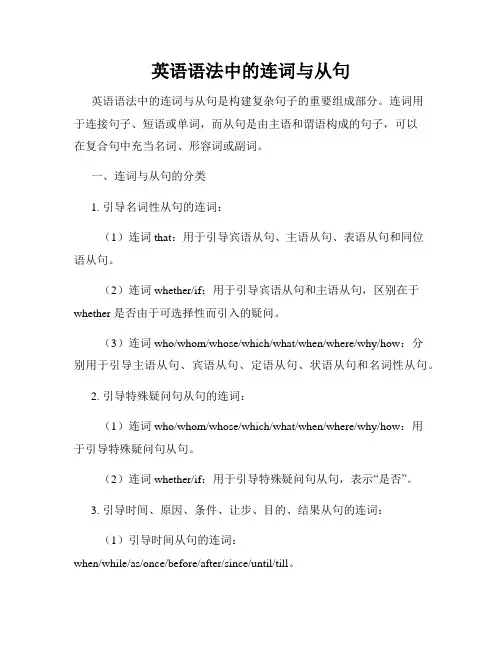
英语语法中的连词与从句英语语法中的连词与从句是构建复杂句子的重要组成部分。
连词用于连接句子、短语或单词,而从句是由主语和谓语构成的句子,可以在复合句中充当名词、形容词或副词。
一、连词与从句的分类1. 引导名词性从句的连词:(1)连词 that:用于引导宾语从句、主语从句、表语从句和同位语从句。
(2)连词 whether/if:用于引导宾语从句和主语从句,区别在于whether 是否由于可选择性而引入的疑问。
(3)连词 who/whom/whose/which/what/when/where/why/how:分别用于引导主语从句、宾语从句、定语从句、状语从句和名词性从句。
2. 引导特殊疑问句从句的连词:(1)连词 who/whom/whose/which/what/when/where/why/how:用于引导特殊疑问句从句。
(2)连词 whether/if:用于引导特殊疑问句从句,表示“是否”。
3. 引导时间、原因、条件、让步、目的、结果从句的连词:(1)引导时间从句的连词:when/while/as/once/before/after/since/until/till。
(2)引导原因从句的连词:because/as/since/now that/for。
(3)引导条件从句的连词:if/unless/so long as/on conditionthat/provided that/as if。
(4)引导让步从句的连词:though/although/even if/eventhough/while/whereas。
(5)引导目的从句的连词:so that/in order that。
(6)引导结果从句的连词:so that/such...that/so...that/enough...to。
二、连词与从句的使用规则1. 从句的位置:(1)宾语从句一般紧跟在动词或介词之后。
(2)主语从句常位于句首。


英语语法连词归纳总结一、单项选择连词1.He smiled politely Mary apologized for her drunken friends.A.as B.ifC.unless D.though【答案】A【解析】A解析句意为:当玛丽因她醉酒的朋友向他道歉时,他礼貌地微笑着。
if如果,引导条件状语从句;unless除非,引导条件状语从句;though虽然,尽管,引导让步状语从句。
as 可引导时间状语从句,表示主从句动作同时发生或前后紧接着发生,常常译为“(正当)……的时候,随着……,一边……一边……”,故只有as符合题意。
2._______ your opinions are worth considering, the committee finds it unwise to place too much importance on them.A.As B.Since C.Once D.While【答案】D【解析】While尽管,在本题中引导让步状语从句。
尽管你的观点值得考虑,委员会发现过于重视它们是不明智的。
3.Stand up _______ you fell down, and I’m sure you’ll succeed in time.A.until B.where C.before D.which【答案】B【解析】考查状语从句。
题中where在……地方,引导地点状语从句,句意:从你跌倒的地方站起来,我相信你最终会成功。
4.The newly-married couple quarreled so much that they reached the point _______ they had to separate from each other.A.when B.where C.which D.that【答案】B【解析】定语从句考查题。
先行词是the point为抽象的地点,关系词where在从句中做状语。
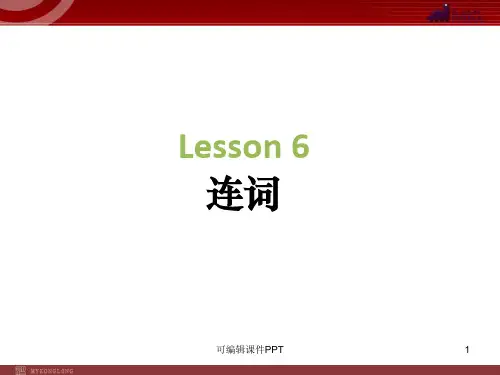
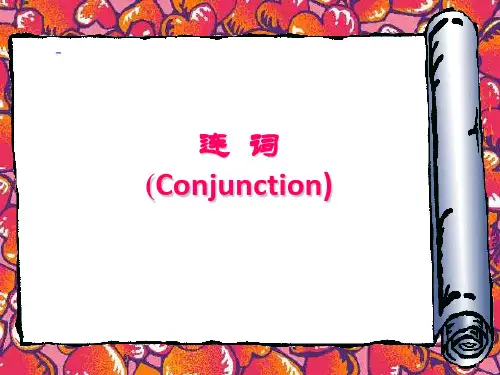
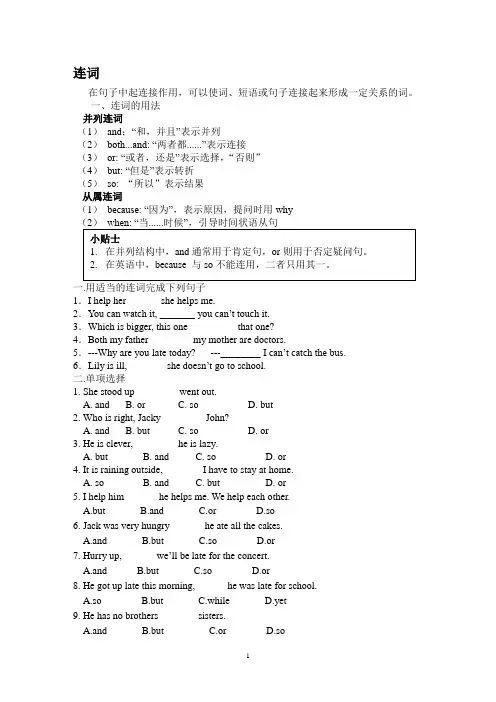
连词在句子中起连接作用,可以使词、短语或句子连接起来形成一定关系的词。
一、连词的用法并列连词(1)and:“和,并且”表示并列(2)both...and: “两者都......”表示连接(3)or: “或者,还是”表示选择,“否则”(4)but: “但是”表示转折(5)so: “所以”表示结果从属连词(1)because: “因为”,表示原因,提问时用why一.用适当的连词完成下列句子1.I help her ______ she helps me.2.You can watch it, _______ you can’t touch it.3.Which is bigger, this one _________ that one?4.Both my father ________ my mother are doctors.5.---Why are you late today? ---________ I can’t catch the bus.6.Lily is ill, _______ she doesn’t go to school.二.单项选择1. She stood up ________ went out.A. andB. orC. soD. but2. Who is right, Jacky ________ John?A. andB. butC. soD. or3. He is clever, ________ he is lazy.A. butB. andC. soD. or4. It is raining outside, _______ I have to stay at home.A. soB. andC. butD. or5. I help him ______ he helps me. We help each other.A.butB.andC.orD.so6. Jack was very hungry ______ he ate all the cakes.A.andB.butC.soD.or7. Hurry up, ______ we’ll be late for the concert.A.andB.butC.soD.or8. He got up late this morning, ______he was late for school.A.soB.butC.whileD.yet9. He has no brothers _______ sisters.A.andB.butC.orD.so1。
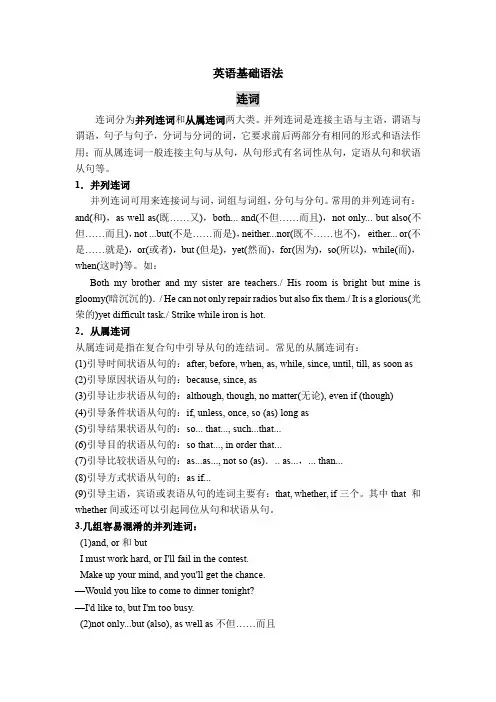
英语基础语法连词连词分为并列连词和从属连词两大类。
并列连词是连接主语与主语,谓语与谓语,句子与句子,分词与分词的词,它要求前后两部分有相同的形式和语法作用;而从属连词一般连接主句与从句,从句形式有名词性从句,定语从句和状语从句等。
1.并列连词并列连词可用来连接词与词,词组与词组,分句与分句。
常用的并列连词有:and(和),as well as(既……又),both... and(不但……而且),not only... but also(不但……而且),not ...but(不是……而是),neither...nor(既不……也不),either... or(不是……就是),or(或者),but (但是),yet(然而),for(因为),so(所以),while(而),when(这时)等。
如:Both my brother and my sister are teachers./ His room is bright but mine is gloomy(暗沉沉的)./ He can not only repair radios but also fix them./ It is a glorious(光荣的)yet difficult task./ Strike while iron is hot.2.从属连词从属连词是指在复合句中引导从句的连结词。
常见的从属连词有:(1)引导时间状语从句的:after, before, when, as, while, since, until, till, as soon as(2)引导原因状语从句的:because, since, as(3)引导让步状语从句的:although, though, no matter(无论), even if (though)(4)引导条件状语从句的:if, unless, once, so (as) long as(5)引导结果状语从句的:so... that..., such...that...(6)引导目的状语从句的:so that..., in order that...(7)引导比较状语从句的:as...as..., not so (as)... as...,... than...(8)引导方式状语从句的:as if...(9)引导主语,宾语或表语从句的连词主要有:that, whether, if三个。
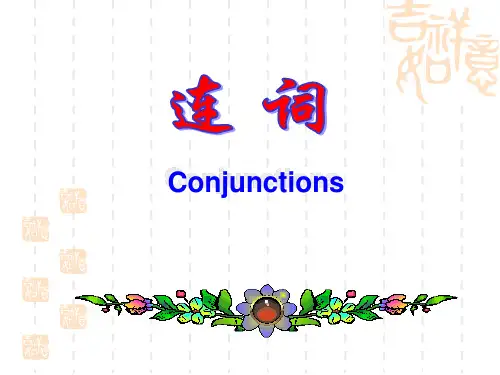

英语语法知识——连词连词是一种起连接作用的词。
连词是虚词,不能单独作句子成分,只能起连接单词、短语或句子(包括从句与分句)的作用。
可分为并列连词与从属连词。
一、并列连词的用法1.并列连词and的用法and可以连接两个的词,多用于肯定句中。
连接两个句子,表示因果、对比、条件、假设、目的等。
例如:(连接两个动词如go, come等表示目的)去取Go andfetch something to eat.些吃的东西来。
andLily is fond of sports.Mary likes music玛丽喜欢音乐,莉莉爱好体育运动。
(对比)One more week and we’ll accomplish the task.再一星期,我们就完成任务。
(条件)的用法2.并列连词both…and,not only…but also, as well as①both…and意为:“不但…而且…;既…又…”,是并列连词,可以并列主语、宾语、表语、状语、谓语等成份。
并列主语时谓语动词用复数形式。
Both New York and London have traffic problems.纽约和伦敦都存在交通问题。
Spanish.The secretaryboth speaks and writes这位秘书不但能讲而且能写西班牙语。
②not o nly…but also 意为:“不但...而且”,是并列连词,可以连接两个词,也可连接两个句子。
其中,but also 中的also可以省略。
not o nly…but also 可以连接句中所有的成份,连接并列主语时,其谓语动词根据就近原则,与所靠近的成分保持数的一致。
not o nly…but also 可以连接两个句子,not only 位于句首时, not only 后的句子要倒装。
Not only the students but (also) their teacher is enjoying the movie.不仅学生们津津有味地看着这部电影,而且他们的老师也是如此。
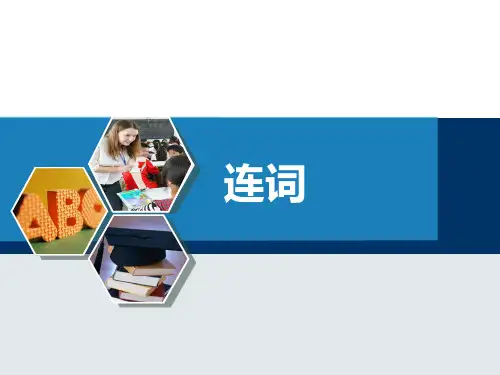
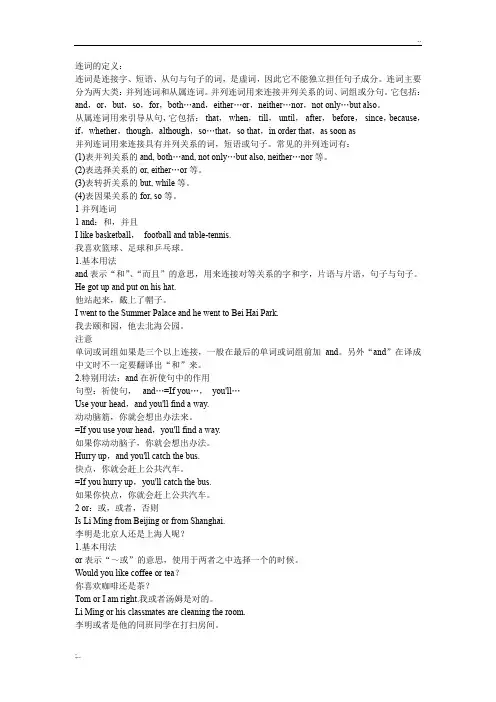
连词的定义:连词是连接字、短语、从句与句子的词,是虚词,因此它不能独立担任句子成分。
连词主要分为两大类:并列连词和从属连词。
并列连词用来连接并列关系的词、词组或分句。
它包括:and,or,but,so,for,both…and,either…or,neither…nor,not only…but also。
从属连词用来引导从句,它包括:that,when,till,until,after,before,since,because,if,whether,though,although,so…that,so that,in order that,as soon as并列连词用来连接具有并列关系的词,短语或句子。
常见的并列连词有:(1)表并列关系的and, both…and, not only…but also, neither…nor等。
(2)表选择关系的or, either…or等。
(3)表转折关系的but, while等。
(4)表因果关系的for, so等。
1并列连词1 and:和,并且I like basketball,football and table-tennis.我喜欢篮球、足球和乒乓球。
1.基本用法and表示“和”、“而且”的意思,用来连接对等关系的字和字,片语与片语,句子与句子。
He got up and put on his hat.他站起来,戴上了帽子。
I went to the Summer Palace and he went to Bei Hai Park.我去颐和园,他去北海公园。
注意单词或词组如果是三个以上连接,一般在最后的单词或词组前加and。
另外“and”在译成中文时不一定要翻译出“和”来。
2.特别用法:and在祈使句中的作用句型:祈使句,and…=If you…,you'll…Use your head,and you'll find a way.动动脑筋,你就会想出办法来。
英语语法:连词教程连词是连接句子、短语或单词的词语,它们在句子结构和语义中起到关键作用。
本教程将介绍一些常见的连词及其用法。
1. 并列连词(Coordinating ns)- 并列连词用于连接两个相同重要性的句子或短语。
- 常见的并列连词有:and(和)、but(但是)、or(或者)、so(所以)等。
- 例句:I like to play tennis, and my brother likes to play soccer.2. 从属连词(Subordinating ns)- 从属连词用于引导从句,并将其与主句连接起来。
- 常见的从属连词有:although(尽管)、because(因为)、if (如果)、when(当)等。
- 例句:Although it was raining, we still went for a walk.3. 连接副词(Conjunctive Adverbs)- 连接副词用于连接两个独立的句子,并且表达句子之间的关系。
- 常见的连接副词有:however(然而)、therefore(因此)、meanwhile(同时)、instead(相反)等。
- 例句:I wanted to go to the party; however, I had too much work to do.4. 转折连词(Correlative ns)- 转折连词用于表达对比或选择关系。
- 常见的转折连词有:either...or(要么...要么)、neither...nor(既不...也不)、both...and(既...又)、not only...but also(不仅...而且)等。
- 例句:She can either go shopping or stay at home.5. 等位连词(Coordinative ns)- 等位连词用于连接两个同等重要的短语或单词。
- 常见的等位连词有:for(因为)、and(和)、nor(也不)、but(但是)、or(或者)、yet(然而)、so(所以)等。
英语语法连词归纳总结连词是用来连接词、短语、句子或句子成分的词语。
它们在英语语法中起到了连接和衔接句子结构的作用。
下面是一些常见的英语连词及其功能的总结:1. 并列连词(Coordinating Conjunctions):用于连接同等重要或平行的词、短语或句子。
- 并列连词有且(and)、或(or)、但是(but)、所以(so)、或者(or)等。
- 例如:I like coffee and tea.(我喜欢咖啡和茶。
)2. 从属连词(Subordinating Conjunctions):用于连接主从复合句,将一个从属分句引入主句中。
- 从属连词有如果(if)、当(when)、因为(because)、尽管(although)、虽然(though)等。
- 例如:I will go to the park if it doesn't rain.(如果不下雨,我会去公园。
)3. 连接副词(Connective Adverbs):具有连词功能的副词,用于连接句子。
- 连接副词有然后(then)、因此(therefore)、此外(besides)、同时(meanwhile)等。
- 例如:I finished my homework. Then, I went to bed.(我完成了作业。
然后,我上床睡觉。
)4. 并列连接词(Correlative Conjunctions):由两个词组成,起到连接和平衡作用。
- 并列连接词有既…又…(both...and...)、不仅…而且…(not only...but also...)、虽然…但是…(although...yet...)等。
- 例如:He is both smart and kind.(他既聪明又善良。
)5. 表示选择的连接词(Conjunctive Adverbs of Choice):用于表示选择关系的副词。
- 表示选择的连接词有不管(no matter)、无论…还是…(whether...or...)、无论是…或…(either...or...)等。
英语语法什么是连词连词在英语语法中扮演着非常重要的角色。
它们用于连接词、短语、句子和句子之间的关系,帮助我们组织思维和表达意思。
在本篇文章中,我将详细介绍连词的不同类型、用法和一些重要的注意事项。
一、连词的定义和分类连词是一类词性,用于连接词、短语、句子和句子之间的关系。
根据其功能和用法,连词可分为以下几类:1. 并列连词(Coordinating Conjunctions):用于连接同等重要的词、短语、句子或句子之间的关系。
常见的并列连词有"and"、"but"、"or"、"nor"、"for"、"yet"等。
2. 从属连词(Subordinating Conjunctions):用于引导从属从句,并将从属从句与主句连接起来。
从属连词在句子中起到连接主从句的作用。
常见的从属连词有"although"、"because"、"if"、"when"、"while"等。
3. 连接副词(Correlative Conjunctions):由两个或多个词组成,用于连接相同类型的词、短语或句子。
常见的连接副词有"either...or"、"neither...nor"、"both...and"、"not only...but also"等。
4. 连接代词(Relative Pronouns):既是代词,又是连词,引导定语从句,并将定语从句与主句连接起来。
常见的连接代词有"who"、"whom"、"whose"、"which"、"that"等。
全力直击英语语法第34讲连词总结
第一部分:连词分类
连词,主要是包括并列连词和从属连词。
在句子中,连词起连接词与词、短语与短语及句子和句子的作用。
它本身在句子里不单独做句子成分。
并列连词:是用来连接语法地位相同的结构、相同的单词、短语及句子。
并列连词有:and, but, or, nor, so, for yet, however, as well as, both...and, not only...but also, either...or, neither...nor, still,
从属连词:用来引导状语从句。
从属连词有:after, when, before, as, while, since, until, till, if, unless, lest, because, than, that, whether, so that, in order that, as if, as though, although, suppose that, provided, that, as...as, now that, such...that, in case that, on condition that
第二部分:连词的用法
在明确的我们的目标之后,我们来具体看看这些连词的用法。
从属连词:。
1、连词的含义:连接词与词、短语与短语、或引导从句的词叫连接词。
2、连词的分类:连词分为并列连接词和从属连接词两种。
1、并列连接词连接并列的词、短语、从句或句子。
常见的并列连接词有:and(和),but(但是),or(或者,否则),nor(也不), so(所以), however(然而,无论如何),for(因为),still(可是),as well as(也),both..and...(...和...), not only ...but also...(不但…而且…), either… or…(或…或…),neither… nor…(既不…也不…)等。
2、从属连接词用于引导从句,常见的从属连接词有:when(当…时候), while(正当…时候), after(在…之后), before(在…之前), since(自从), until(直到), although/though(虽然), if(假如), as(如…一样;由于), as …as…(和…一样), as far as(就…而言), as long as(只要), as soon as(一…就…), even if(即使), because(因为), unless (除非), than(比…), whether (是否…), in order that…(为了), so…that…(如此…以致), so that…(以便), now that…(现在既然), by the time…(到…时候), every time…(每当), as if…(仿佛),no matter when(或whenever)(无论何时),no matter where(或wherever)(无论在哪里)等。
[辨析](1)because、as、since、for的用法:because(因为)表示原因的语气最强,常表示必然的因果关系,从句一般放在主句后面;另外,回答why的问句只能用because. as(因为)表示一般的因果关系,语气比because弱,说明比较明显的原因,它引导的从句可以放在句首也可以放在句尾。
英语语法连词归纳总结一、单项选择连词1.He smiled politely Mary apologized for her drunken friends.A.as B.ifC.unless D.though【答案】A【解析】A解析句意为:当玛丽因她醉酒的朋友向他道歉时,他礼貌地微笑着。
if如果,引导条件状语从句;unless除非,引导条件状语从句;though虽然,尽管,引导让步状语从句。
as 可引导时间状语从句,表示主从句动作同时发生或前后紧接着发生,常常译为“(正当)……的时候,随着……,一边……一边……”,故只有as符合题意。
2.— How can I wake up so early?—Set the alarm at 5 o’clock,you’ll make it.A.but B.or C.and D.so【答案】C【解析】试题分析:考查情景交际和并列连词。
句意:--我怎样才能醒的很早?--把闹钟定到5点,这样,你就能做到了。
答语前后是并列关系,祈使句+and表示条件,相当于if条件句。
or 表示相反的情况,故选C。
考点:考查情景交际和并列连词3._____ astronauts cannot go to a baseball game or a movie in space, there are many familiar activities that they can still enjoy.A.Once B.Unless C.While D.Since【答案】C【解析】while在此句中作为连词,表让步,意思是“虽然,尽管”。
句意:在太空中,宇航员们虽然不能去看棒球比赛或看电影,但那里还有很多相类似的活动他们仍然是可以玩的。
考点:连词/连接词4.How long do you think it will be ________ the computer company brings out a new product? A.until B.when C.before D.that【答案】C【解析】分析句子,可知这是一个时间状语从句。
连词的定义:连词是连接字、短语、从句与句子的词,是虚词,因此它不能独立担任句子成分。
连词主要分为两大类:并列连词和从属连词。
并列连词用来连接并列关系的词、词组或分句。
它包括:and,or,but,so,for,both…and,either…or,neither…nor,not only…but also。
从属连词用来引导从句,它包括:that,when,till,until,after,before,since,because,if,whether,though,although,so…that,so that,in order that,as soon as并列连词用来连接具有并列关系的词,短语或句子。
常见的并列连词有:(1)表并列关系的and, both…and, not only…but also, neither…nor等。
(2)表选择关系的or, either…or等。
(3)表转折关系的but, while等。
(4)表因果关系的for, so等。
1并列连词1 and:和,并且I like basketball,football and table-tennis.我喜欢篮球、足球和乒乓球。
1.基本用法and表示“和”、“而且”的意思,用来连接对等关系的字和字,片语与片语,句子与句子。
He got up and put on his hat.他站起来,戴上了帽子。
I went to the Summer Palace and he went to Bei Hai Park.我去颐和园,他去北海公园。
注意单词或词组如果是三个以上连接,一般在最后的单词或词组前加and。
另外“and”在译成中文时不一定要翻译出“和”来。
2.特别用法:and在祈使句中的作用句型:祈使句,and…=If you…,you'll…Use your head,and you'll find a way.动动脑筋,你就会想出办法来。
=If you use your head,you'll find a way.如果你动动脑子,你就会想出办法。
Hurry up,and you'll catch the bus.快点,你就会赶上公共汽车。
=If you hurry up,you'll catch the bus.如果你快点,你就会赶上公共汽车。
2 or:或,或者,否则Is Li Ming from Beijing or from Shanghai.李明是北京人还是上海人呢?1.基本用法or表示“~或”的意思,使用于两者之中选择一个的时候。
Would you like coffee or tea?你喜欢咖啡还是茶?Tom or I am right.我或者汤姆是对的。
Li Ming or his classmates are cleaning the room.李明或者是他的同班同学在打扫房间。
注意“A or B”作主语时,谓语动词随or后面的词(B)而定,因此例子中的谓语动词服从I,用am。
2.特别用法句型:祈使句,or…=If you don't…,you'll…同and一样,or在祈使句中的用法,译成“请…,否则…”,有转折的意思。
Hurry up,or you'll miss the bus.快点吧,否则你就会误了公共汽车。
=If you don't hurry up,you'll miss the bus.如果你不快点,你就会误了这班车。
Study hard,or you'll fail in the exam.好好学吧,否则你考试就会不及格。
=If you don't study hard,you'll fail in the exam.如果你不努力学习,你考试就会不及格。
注意or疑问句的读法or前面的部分用升调,后面的部分用降调。
3 but:但是,可是,而He is old,but he looks very young.他老了,但他看起来很年轻。
Li Li likes violin but doesn't like piano.李莉喜欢小提琴,(但是)不喜欢钢琴。
(but 后面省略了主语Li Li,因为与前面的主语成分相同)Mary likes violin,but Tom doesn't.玛丽喜欢小提琴,而汤姆不喜欢。
(doesn't后面省略了like violin,因为与前面的成分相同)He isn't a teacher but a doctor.他不是(一个)老师,而是医生。
They came here not for money but for the life.他们到这儿来,不是要钱,而是要命。
注意but所连接的句子,句中如果某些成分与前面相同,则可以省略。
4 so,forIt began to rain,so we had to stay here.开始下雨了,我们不得不呆在这儿了。
1.so:所以,因此,于是My teacher asked me to go,so I went.我们老师让我去,因此我就去了。
比较so除了作连词外,也可以作副词。
I hope you can pass the exam.我希望你能通过考试。
I hope so.我也希望。
Don't walk so fast.别走得太快。
2.for:因为I soon went to sleep,for I was tired.我很快就入睡了,因为我太累了。
The sun has risen,for the birds are singing.太阳升起来了,小鸟在唱歌。
比较for和be cause for也可译为“因为”,但是它没有什么因果关系,不像because那样,而for 只是说明解释而已。
5 both…and:和,既……也……He can play both the violin and the piano.他既会拉小提琴,又会弹钢琴。
1.《both…and…》构成的词组作为主语时,谓语动词用复数。
Both Li Ming and Li Li are good students.(Li Ming和Li Li都是人,所以两者对等)李明和李莉都是好学生。
注意在《both…and…》句型中,and连接的词或词组要对等。
2.《both…and》的否定句表示部分否定。
He can't play both the violin and the piano.他会拉小提琴或者会弹钢琴。
(不全会)Both Li Ming and Li Li are not good students.明和李莉不都是好学生。
(其中一个是好学生)6 either…or,neither…norI want to visit either Tianjing or Shanghai.我想参观天津或者上海。
I like neither English nor Chinese.中文和英文我全不喜欢。
1.either…or:或……或……;不是……就是……a.《either…or…》构成的词组作为主语时,谓语动词随其邻近的词,即or后面的词而定。
Either you or he is right.不是你,就是他是对的。
b.此句型的否定句是全否定。
Either you or he isn't right.你和他都不对。
I don't want to visit either Tianjing orShanghai.天津和上海我都不想参观。
2.neither…nor:既不……也不……a.当此词组担任主语时,谓语动词的用法和either…or的用法一样,由nor后面的词而定。
Neither you nor I am right.你和我都不对。
b.此句型本身是全否定,因此不能再用否定式,即不能再加not。
(×)Neither You nor I am not right.比较both …and ,either…or ,neither …nor 这三个句型的相互关系如下:1.肯定句:I like both A and B.我喜欢A和B。
I like both coffee and tea.我喜欢咖啡和茶。
(茶和咖啡我都喜欢)2.否定句:I don't like both A and B. =I like either A or B.我不喜欢A 或B。
I like either coffee or tea .咖啡和茶,我喜欢一样儿。
=I don't like both coffee and tea .3.I don't like either A or B .=I like neither A nor B.A和B 我都不喜欢。
咖啡和茶,我都不喜欢。
I like neither coffee nor tea .I don't like either coffee or tea .7 not only…but also:不但……而且(1)Not only you but also your father is coming.不但你,而且你父亲也要来。
(2)Jane is not only beautiful but also kind.珍妮不但漂亮,而且人非常好。
1.基本用法:《not only…but also》担任主语时,此句型的谓语动词随but also后面的部分而定,参见上文例(1)。
另外not only…but also连接对等的词或词组;例(1)you(你)和your father(你父亲)都是人。
例(2)beautiful(美的)和kind(亲切、慈祥)都是形容词。
2.该句型可以和“as well as”互换,但注意汉语翻译。
Your father as well as you is coming.不但你,而且你父亲也要来。
注意as well as的句子谓语动词随它前面的词“Your father”而定,所以用is coming.Jane is kind as well as beautiful.珍妮不但漂亮,而且为人很好。
2 从属连词常见的从属连词有:(1)引导时间状语从句的after, before, when, while, as, until, till, since, as soon as等。
(2)引导条件状语从句的if, unless等。
(3)引导原因状语从句的because, as, since等。
(4)引导目的状语从句的so that, in order that等。